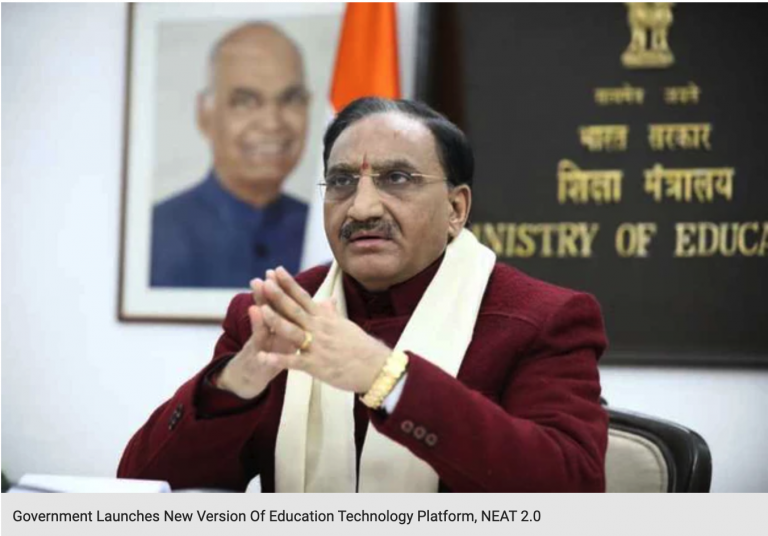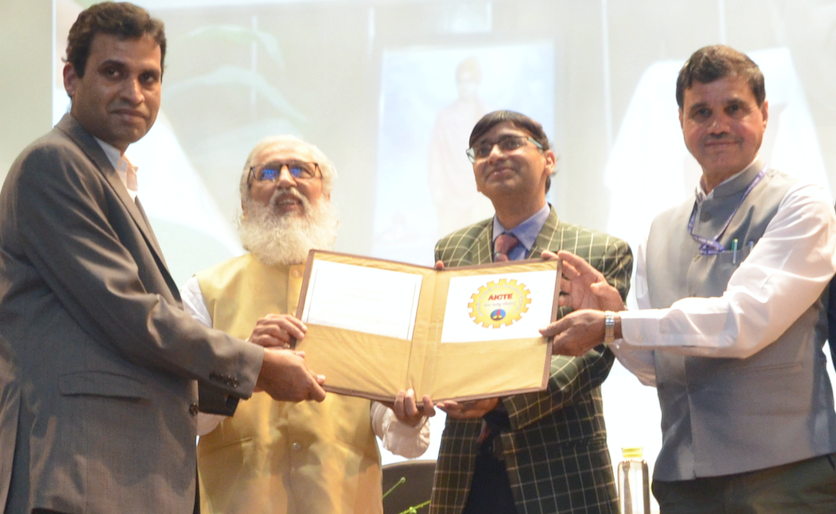News & Updates
- CIOReview awards prepbuddies as the most promising education technology solution companies
- Government of India (AICTE) partners with prepbuddies for the dissemination of digital coursework to students in higher ed institutes
- Stopgap online teaching to evolving smart education: 2020 at IIT Kharagpur
- The Full Story on Admissions
- Top Features To Compare Before Applying For An Abroad Education Loan
CIOReview awards prepbuddies as the most promising education technology solution companies, 2021.
Source: https://education.cioreview.com/vendor/2021/prepbuddies| Published: May 17th, 2021
The last few decades have witnessed significant and exceptional technological innovation in the realm of education, drastically transforming the pedagogical design of teaching and learning processes. With the rise of online learning over the years, students and faculty members have access to enterprise-wide, repository-based, ubiquitous, socially oriented technologies such as Learning Management Systems (LMS) and virtual learning environments, which are transforming the nature of institutional teaching and learning processes. However, the recent COVID-19 pandemic brought the education world into uncharted waters, necessitating the rapid adoption of online learning across the globe. This paradigm shift has raised many concerns about this mode of education and the challenges associated with providing a prompt response.

Dharmendra Verma (Dharma), a management consultant and technology evangelist whose professional experience spans Fortune 100 companies, has observed the evolution—or the lack thereof in the education landscape. As someone who has earned significant experience throughout his educational journey across various universities and in global consulting, Dharma was well ahead of his peers in understanding the need for digital transformation in education. In 2018, recognizing an unmet need in the education space, Dharma conceived the idea of providing one application for all course needs—online classes, lecture videos, reference materials, assignments, online assessments, tutorials, discussion, and more—that will streamline a faculty member’s efforts to design, create, and update course content, while improving the learning experience of the students. This vision is what cemented the cornerstone of prepbuddies—an Artificial Intelligence (AI) based collaborative learning platform that enables institutes to engage the students for online classes, share lecture videos and reference material, conduct online tests, organize discussions, and much more—all from a single system.
Spearheading transformation in the online learning space, prepbuddies an Artificial Intelligence (AI) based collaborative learning management platform, engages the students in online classes, lectures videos, reference materials, assessments, tutorials, and discussions with peers and faculty members, thereby improving the learning experience of the students. From lectures to assessments to discussions, prepbuddies addresses a student’s educational needs in single platform. Faculty members at universities and schools are using the platform to organize and manage all the coursework without juggling through multiple applications. From a student’s perspective, prepbuddies offers all study material in a single application that can be accessed from the web or on a mobile app, eliminating the distractions that may arise from accessing multiple applications. “In most cases, students submit their questions on the topics via Slack, Concord or other app but with prepbuddies, students can watch lectures, attend online classes, submit assignment and engage in discussions with faculty, teaching assistant, or other students all via one single application,” explains Dharma, Founder of prepbuddies.
With a sharp focus on user data security, prepbuddies was specifically designed to transform the online learning experience while also enforcing security by leveraging Amazon Web Services (AWS) to host its platform. prepbuddies has measures in place to allow students to have access to relevant courses using their logins. With institutes having complete control over who can access which course, admins can grant and manage privileges of enrolled students to their coursework. The platform also has a failsafe feature using which an institute admin can rectify any inadvertent student mistakes in enrolment. prepbuddies is designed to protect the intellectual property of the content creators ensures that users cannot download lectures and post it on other platforms. Taking data security a step further, prepbuddies restricts institute admins from accessing student data, thereby protecting student identity. “Each user has a unique username and password, and users can change their password using a one-time code sent to the registered email ID. This two-factor authentication feature ensures that student accounts are protected from unauthorized access” adds Dharma. In a nutshell, prepbuddies, lets admins seamlessly deliver engaging and secure experiences to students, scale their programs while also lowering costs and operational burden.
“With prepbuddies, students can watch lectures, attend online classes, engage in discussions with faculty, teaching assistants, or fellow students, and submit assignments, all using one single application. prepbuddies empowers institutes to put access to knowledge on students’ fingertips, allowing students to study on the GO.“
The uniqueness of prepbuddies stems from the flexibility it offers to users—a ‘wow’ factor that delivers a delightful user experience. Working closely with institutes, prepbuddies incorporates stakeholder feedback into the platform. prepbuddies has demonstrated its prowess as an online learning management platform by helping clients in India, where online education continues to rapidly evolve and mature. In February 2021, the All India Council for Technical Education (AICTE) partnered with prepbuddies to improve the teaching and learning experience of the faculty and students in higher education institutions in the country. This partnership project—The National Education Alliance for Technology 2.0 (NEAT 2.0)—has been conceived with the goal of combining public and private initiatives in education technology and online learning onto a single platform.
Government of India (AICTE) partners with prepbuddies for the dissemination of digital coursework to students in higher ed institutes
Source: https://www.ndtv.com; Published: 16th February, 2021
The All India Council for Technical Education (AICTE) has launched the second edition of NEAT today. The National Education Alliance for Technology 2.0 (NEAT 2.0) is aimed at bringing together public and private initiatives in education technology and online learning to a common platform. The first version of NEAT was announced in 2019. The Union Minister of Education Ramesh Pokhriyal ‘Nishank’ also attended the launch of NEAT 2.0 today, February 16.

Along with the Minister of Education, Professor Anil D Sahasrabudhe Chairman of AICTE; Professor MP Poonia, Vice Chairman of AICTE; Professor Rajive Kumar, Member Secretary, AICTE; and Buddha Chandrasekhar, CCO, NEAT, AICTE were present at the launch of NEAT 2.0.
As part of the NEAT 2.0 launch, as many as 48 companies have signed an agreement with AICTE. The technical education regulator, AICTE, will act as a facilitator and ensure that the services of these 48 companies are available free or at a lower price to the economically and socially backward students.

With Memorandum of Understanding between Government of India and prepbuddies: Mr. Dharmendra Verma (Founder, prepbuddies), Prof. Anil D Sahasrabudhe(Chairman, AICTE), Dr. Buddha Chandrasekhar (CCO, NEAT), Prof. MP Poonia (Vice Chairman, AICTE)
prepbuddies provides AI-based Learning Management System and online assessment platform. Higher Education Institutes can complement the class room based teaching with the digital content through prepbuddies and access the students’ progress in the course by offering quizzes and tests through prepbuddies. Faculty members can now conduct online classes, share Lecture Videos and reference material, upload and evaluate assignments, access students’ performance, and organise discussions among students – All from prepbuddies instead of using multiple applications.
During the launch of NEAT 2.0, Mr Pokhriyal said: “I am happy that my students have shifted their focus from package culture to patent culture.” He also stressed on enabling linkages between the industry and academia for better result.
“Inaugurating NEAT 2.0 , Ramesh Pokhriyal, Minister of Education, Government of India, said, “This is a great initiative from the Ministry of Education and AICTE. I hope NEAT 2.0 will be a new beginning in the history of Indian education. This will help millions of students to upgrade their skill sets as per Industry needs. This initiative has proved to be a great blessing for lakhs of students and it’s a big step towards Atmanirbhar Bharat initiative as NEAT helped home grown edutech companies to grow on global level. “
Mr Nishank also reiterated on how MOOCs, SWAYAM Prabha have been playing an important role in disseminating education. This NEAT 2.0 scheme, the education minister said, will serve as a platform for students who do not have access to the right kind of platform to gain skills as per their talent.
Buddha Chandrasekhar, CCO, NEAT, AICTE, during the launch said that through the NEAT platform, many edtech companies are accessible on a common platform to have a wider reach across the country.
Stopgap online teaching to evolving smart education: 2020 at IIT Kharagpur
Source: https://www.abpeducation.com; Published: 20th December, 2020

Teachers at the Indian Institute of Technology (IIT), Kharagpur, may start using graphics-enabled tablets as the institute starts calling back students in a phased manner in 2021. A year that saw nearly 38 million students taking to online education saw IIT Kharagpur not only adopting a host of platforms for imparting online education but also evolving a new pedagogy for a better student experience.
Experts at a recent Pan-IIT US forum pointed out that 97% of IIT students and their families want to return to campuses. IIT Kharagpur director Virendra Tewari said a hybrid model is not a practical solution for IITs, especially at the postgraduate level. “We will be calling back students in a phase-wise manner and they would go through quarantine before returning to the labs,” he said.
A look at how IIT Kharagpur managed to sail through 2020: Adopting technical aids
IIT Kharagpur, which caters to about 14,000 students, collaborated with Microsoft and Prepbuddies, an AI-based platform, for interactive online education.
MS Teams enabled quick conversation with students, sharing of files and web links, built-in e-notebook for the classroom, management of interactive lessons and assignments. “MS Teams was of great use as the lectures could be recorded and students could watch them later while being connected to their professors at all times for doubt-clearing,” said Pranjal Shukla, a third-year student of civil engineering.
“Prepbuddies, developed by IIT Kharagpur alumnus Dharmendra Verma, was used for digital dissemination of the classroom resources, practice work, assignments and monitoring student performance analytics. Siddhartha Mukhopadhyay, head of the electrical engineering department and School of Energy Science and Engineering, said the platform offered students a unified experience through recorded videos of classes and discussion forums, in addition to live classes. The evolving status of the software further makes it more dynamic in terms of new features, he added.”
Evolving the teaching and learning process
While technical aids and software powered online education, online delivery of lessons and tracking progress had to be redefined. “This new mode of online lecture delivery did not restrict the teachers’ innovation, rather paved a way to become more innovative. New modes of assignments and lecture delivery such as showing graphics and relevant video demonstrations were adopted as components of the lecture delivery process. The lectures were no longer restricted to PPT but involved various applications,” said G.P. Raja Sekhar, dean, faculty of sciences.
Comprehensive-type open-book exams and time-bound pen-and-paper tests were conducted for evaluation. Students submitted scanned answer scripts by email within 10-15 minutes of the test. Annanya Singh, a fourth-year aerospace engineering student, said added monitoring by teaching assistants during online class tests made the test experience more realistic.
New semester plan
Teachers have been recommended to use graphics-enabled tablets and engage in regular two-way interactions with students during classes for the upcoming Spring 2021 semester.
“One option is creating multiple sets of question papers, keeping the nature of each question intact. This can be further coupled with random MCQs with shuffled options. We already conducted online quizzes similar to GATE with a mixture of MCQ and NAT-type questions in the autumn semester using Microsoft Teams,” said Joy Krishna Dey, associate dean, faculty of sciences.
Shikha Bagaria, a second-year student of chemical engineering, said the rush felt in the previous semester will be addressed as the spring semester is expected to start at the usual time and with better management of the online process.
Challenges of online education
A key issue in online education that has remained unresolved are the hardware and network facilities. Akshat Jain, a fourth-year student of agricultural and food engineering, lauded the overall arrangements despite challenges but shared his concern about the continuous evaluation system that many students found inconvenient in the absence of proper connectivity at home.
“This issue needs to be addressed at a more macro level, beyond the scope of an individual institute. We did a survey to identify the status of the internet connectivity of the students. The results are being analysed to develop diverse modes of tutorial and teaching communication,” said Raja Sekhar.
Laboratory classes remain a challenge. In addition to virtual labs, some experiments can be demonstrated through specialised online videos or through computational models. “Students are being encouraged to run experiments using sensors, tools, electrical and electronic components that can be bought from online marketplaces thus enabling them to build their own micro-labs wherever possible,” said Siddhartha Mukhopadhyay.
The Full Story on Admissions
Source: https:insidehighered.com; By Scott Jaschik; Published: February 1, 2021
You may be reading about record application totals, but they are largely going to the institutions that already have plenty. Other colleges are not doing well. Common App data point to declines from low-income students.

In the West, the headline in the Los Angeles Times was “UC’s Record-Smashing Applications Put Long-Held Diversity Goals Within Reach.” The story detailed the University of California’s systemwide increase of 16 percent in applications. But it noted the Black applicants increased by 48 percent at both Berkeley and UCLA. Latinx applicants increased by 33 percent at UCLA and 36 percent at Berkeley. The University of California is test blind this year, meaning that it won’t look at test scores in admissions.
Both articles are entirely accurate about what is happening in the top sector of admissions. But both give minimal mention to other realities this year.
Many colleges outside the top ones — public and private alike — are not having a good year in admissions. This appears to be especially the case in the Northeast, Mid-Atlantic and Midwest.
Jim Malatras, the chancellor of State University of New York system, wrote a column published in Empire Report in which he said that the SUNY system had seen an application decline this year of “20 percent, one of the largest annual decreases in the system’s 73-year history.”
And SUNY itself demonstrates the difficulty of coming up with trends this year. Its campus at Binghamton is up 2 percent in applications. Generally, SUNY’s university center campuses (at Albany, Binghamton, Buffalo and Stony Brook) operate in a different world from the rest of the system.
What’s going on this year?
- Application increases at top colleges will not (by themselves) translate into more access to higher education. Most of these colleges are not growing. Plus, the increase in high school graduates this year is expected to be less than 1 percent. The increases in minority applications to Berkeley and UCLA may well result in more of those students getting in, but others will be rejected. But even a seemingly significant change in minority enrollments at these universities won’t move the needle much nationally.
- Yield will be very difficult for colleges to predict. With applications way up — Colgate had a 102 percent increase in applications — the formulas used by many colleges will not be something they can rely on. Some colleges plan to make more use of waiting lists.
- Deadlines — outside of top colleges — are flexible. Some colleges are open about this, and others are not. But the reality is that for colleges that are seeking students, they are open to talking, even if they had a Jan. 15 deadline (and in all likelihood the Jan. 15 deadlines have vanished for most colleges).
Many colleges (outside the top ones) aren’t talking about their admissions year in public. But some are.
“Newly released data about the Common App show that what has been reported anecdotally in admissions is actually occurring in large numbers. The larger and more competitive colleges and universities are having a good year and getting lots of applications. But smaller and less competitive colleges are not. And first-generation students and those who lack the money to pay for an application are not applying at the same rates they used to.”
Top Features To Compare Before Applying For An Abroad Education Loan
Source: https://www.gyandhan.com; Published: 10th December, 2020
An education loan is a right option for students who want to pursue higher studies abroad but do not have enough money to fund the studies. In today’s time, getting an abroad education loan in India has become relatively easier. But, in absence of proper information and guidance, many students end up taking education loans at a higher rate of interest or make some avoidable mistakes. To avoid such situations, here are the top factors that a student must compare or know before applying for an abroad education loan:
Interest Rate
Interest rate is unquestionably the most vital factor to consider while applying for an abroad education loan. Also, the interest rate on loans does not always remain the same throughout the loan tenure and therefore it is essential to look at whether the interest rate is fixed or floating.
A loan with or without collateral
Most of the features of an abroad education loan are based upon the fact that whether you are going for a secured or an unsecured loan. The ROI (rate of interest) is notably lesser in the case of loans with collateral. Loans without collateral, as they don’t require any tangible or intangible asset to be vouchsafed, include a higher ROI that can be somewhere between 11-15%.
Moratorium Period
The moratorium period refers to the grace period during which you will not have to make any principal amount repayment. It’s the waiting period after which your loan repayment will begin. Usually, the banks give a moratorium period of 6 months to 12 months. Also, according to the type of loan you choose, you might have to pay a simple or partial interest rate during your study period.
Processing Fee
In addition to the loan amount, banks also impose some other charges that have to be compensated by the applicant and one of these charges is the processing fee which can range from 0-2% of the loan amount based upon the lender. It is essential to know about the processing fees at the beginning of the loan process. You must take this expense into consideration as well while deciding on the abroad education loan.
Pre-payment Penalty
A pre-payment penalty is levied by the lender when you pay off the loan before the pre-decided loan tenure. This penalty differs on the basis of the time at which you are doing the loan foreclosure. This penalty can range from 2-4% of the remaining loan amount. It is important to plan for such an event in prior, specifically for the students of premier colleges who have excellent odds of getting a well-paying job and would be able to pre-pay the loan easily.
All the above features might sound quite burdensome for you to compare as they take in an insightful understanding of financial verbiages. With GyanDhan, you can now put all the troubles of choosing the best education loan product for you on them. It is a study abroad financing marketplace that helps abroad study aspirants in securing education loans from government banks, private banks, and NBFCs- free of cost!
All you need to do is to check your loan eligibility and if you are eligible, their education loan counselor will contact you and will suggest the best education loan options for you! You can stay at peace in your home and GyanDhan will do all the work to make sure that you get an abroad education loan without any trouble!
